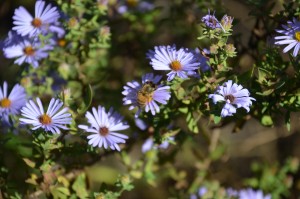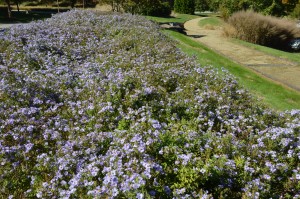New England (NE) Aster (Symphyotrichum novae-angliae), aka Michaelmas Daisy, is a long-lived native perennial from the east shore west to New Mexico (USDA hardiness zones 4-8). Flowering time is from August to October. It is a favorite choice for prairie restorations, roadside plantings, and wetland sites.
This large aster species grow up to 6 feet high and stems and leaves are covered with tiny hairs. Basal leaves are alternate, entire (no teeth), and may grow to 4 inches in length. Flower colors range from lavender, blue, pink, or white.
From mid-August until early October, hundreds of blue purple to lavender flowers (to 1 ½ inches across) cover the plant canopy; ray petals surround a center burnt orange-yellow eye. Sap from crushed leaves emits a strong turpentine smell.
NE aster prefers full sun and well-drained, moist, humus-rich soil. This aster species does not survive if winter soils stay constantly wet or soggy.
For best appearance tall varieties are best pinched back once or twice by mid-summer for increased branching and more flowers. NE asters are good performers in containers. Plants should be divided in late winter or early spring to retain clump vigor every 3-4 years.
Leading NE aster cultivar is ‘Purple Dome’ with lavender blue flowers. This cultivar is very different in that plants are naturally low and bushy. Purple Dome aster grows 18-24 inches tall and up to 3 feet wide on thick and sturdy stems. Staking is rarely needed.
Diseases include various forms of fungal stem-rot and its cause is usually traced to wet soils. “Yellows disease”, caused by a virus, results in sudden wilt and death.
Bees and butterflies frequent asters and deer stay away. Late blooming asters are an important nectar source for these pollinators, especially Monarchs that are migrating to Mexico in late autumn.



 Posted in
Posted in 
